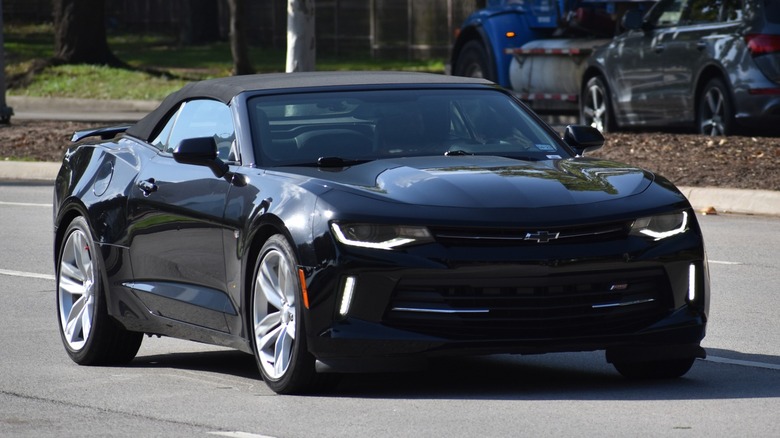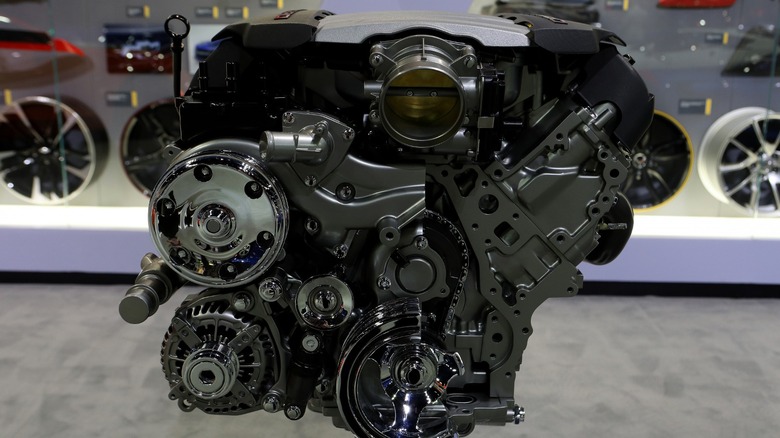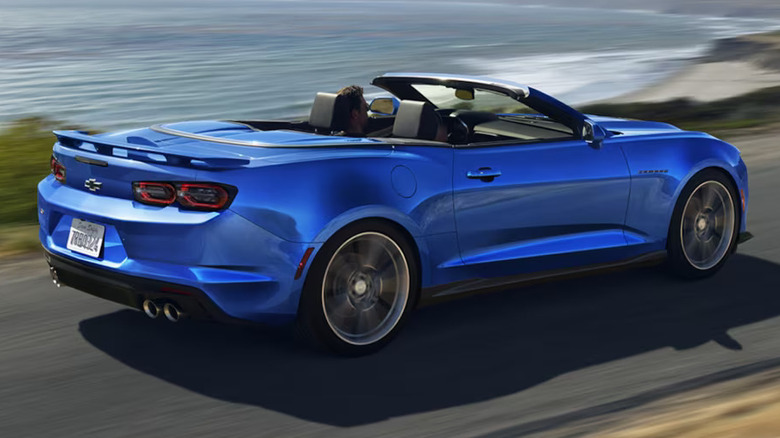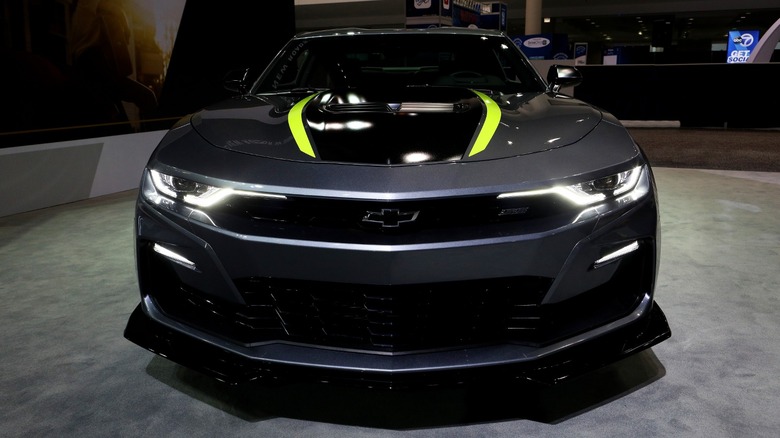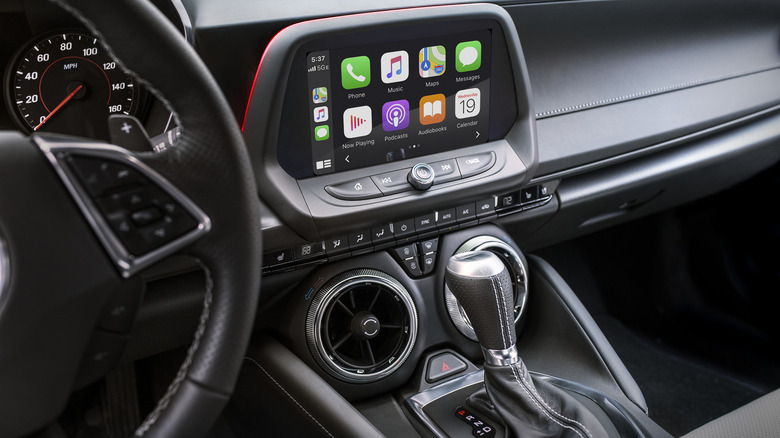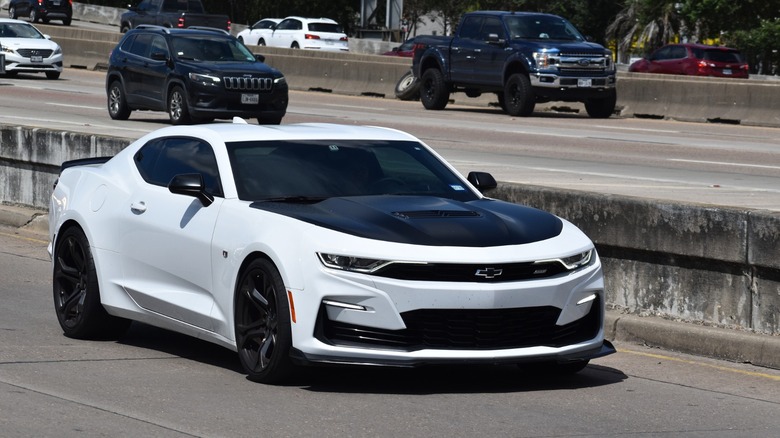What's The Difference Between Chevrolet Camaro 1LS And LT1?
The Chevrolet Camaro has been one of America's most iconic pony cars since its introduction in 1967. It was continuously produced for over 50 years, save for an eight-year hiatus between 2002 and 2010. Unfortunately, Chevrolet announced that it will once again discontinue the Camaro after the 2024 model year. That means buyers now only have a limited time left before brand-new stocks of the iconic Camaro run out.
However, the top-of-the-line Chevrolet Camaro ZL1 starts at over $73,000, not including taxes, dealer fees, options, and more. This makes it out of reach for many buyers, dashing the dreams of those who want to own one before the last car rolls out of the factory. Thankfully, the 2023 Camaro came in eight trims, with the base 1LS starting at $27,795, and the mid-range LT1 costing $37,795. The 2024 Camaro drops the base 1LS trim and begins with the 1LT for $32,495, while the 2024 Chevrolet Camaro LT1 now starts at $40,395.
If you're eager to get your hands on one of the last Camaros, but don't want to spend over $70,000 on a car, consider these base and mid-range options. Let's compare the 1LS and LT1 trims and see which ones are worth your hard-earned money.
Powertrain options for both
As the 2023 1LS trim is the Camaro's most affordable trim, it comes with the smallest engine — a 2.0 liter inline-4 turbo gasoline engine that outputs 275 horsepower, and 295 pound-feet of torque. Although the 1LS has a small engine, it's not exactly a slouch either. It's also paired with a six-speed manual transmission, so you have to row your own gears for a fun drive.
But if you go for the mid-range LT1 trim, you'll trade the little four-banger for a 6.2-liter V8 that delivers 455 horsepower and 455 pound-feet of torque. Just like the 1LS, you also get a six-speed manual transmission to power the rear wheels. This is the same engine you get with the 2024 model, so you're not missing out on power even if you pick the 2023 Camaro LT1.
Optional extras for both the 1LS and the LT1 include a paddle-shift automatic transmission (eight-speed for the 1LS, 10-speed for the LT1). Furthermore, if you go with the LT1, you can get a dual-mode exhaust for a more aggressive exhaust sound. However, this option isn't available on the 1LS.
Braking and suspension options
In the braking department, the 1LS gets four-wheel ABS disc brakes. However, the LT1 gets Brembo-branded front-performance antilock brakes for better braking. Also, the base 1LS gets a four-wheel independent sport suspension, while the LT1 has an upgraded performance suspension with dampers, rear cradle mounts, ball-jointed rear toe links, and stabilizer bars.
If you pick the mid-range LT1, you also have the following options: A black strut tower brace, orange or red-painted brake calipers, and a 2.77-ratio rear axle. You can also get the sway bar suspension upgrade, which reduces vehicle roll by 18%. However, this upgrade also requires the SG3 Lowering suspension upgrade, meaning you must shell out more money to enjoy this upgrade.
These upgrades will make the LT1 far more agile than the 1LS. But because they're optional, the cost increase will make an even bigger difference between the base and mid-range trims. All these options could go over $7,000, and the LT1's price could hit over $45,000.
Exterior differences
Larger wheels are one of the tell-tale differences between lower and higher trims on most cars, and that's the same case with the Camaro. The base 1LS only comes standard with 18-inch silver-painted aluminum wheels wrapped in 245/50 all-season tires. Buyers get 20-inch silver aluminum wheels with the LT1, this time with 245/40 all-season run flats.
However, the LT1 lets you pick from nine other 20-inch aluminum wheels in varying finishes and colors. You also have three design packages as options, and a ground effects package to make your Camaro look like it's hugging the ground with an added body kit. Alternatively, you can go for the optional RS package, which gives you 20-inch 5-split-spoke aluminum wheels, LED lighting, tinted tail lamps, black bowtie emblems, and a decklid-mounted lip spoiler.
On the other hand, the 1LS doesn't have as many options. Nevertheless, you still get options like spoilers, body and center stripes, tinted tail lamps, and more.
Interior features
Both the 1LS and LT1 get a six-speaker audio system, an eight-way power driver seat, a seven-inch diagonal color touchscreen, cruise control, a leather-wrapped shift knob and steering wheel, a rear camera, a tire pressure monitoring system, and wireless Apple CarPlay and Android Auto.
However, if you go for the higher trim, you also get a six-way power passenger seat and a 12-month SiriusXM Platinum subscription. You also have the following options for the LT1, but not the 1LS: Alloy sport pedals, Bose premium audio system, an eight-inch infotainment system, Recaro front bucket seats, and suede shift knob and steering wheels.
You don't get much in terms of standard interior equipment with the LT1 over the 1LS. However, the optional extras you can only get on the LT1 can make the $10,000 price difference worth it — like the bucket seats, the Bose speakers, and the bigger infotainment system. But remember that these are extras, so you have to shell out more to get them. This could drive the sticker price to over $50,000, especially if you added other options as well.
Should you go for the 1LS or the LT1?
If you simply want a piece of history with the Camaro, and don't want to spend more than necessary, the 1LS should be more than enough. Although it doesn't have the V8 power of the LT1 and all the bells and whistles, you could at least have one of the last Camaros in your driveway.
If you're after performance and comfort and can afford the $10,000 premium of the mid-range model, the LT1 is a good compromise between price and performance. Of course, it will not be as powerful as the ZL1, but for a starting price of less than $40,000, the LT1 is already a good start.
Since the Camaro is also a pretty popular model, they aren't that expensive to own and maintain. That means you can keep it for a long time and slowly upgrade it over the years if you wish. With that, you might eventually increase its performance and build a powerful car from your 1LS that will rival the horsepower of even the ZL1 trims.
